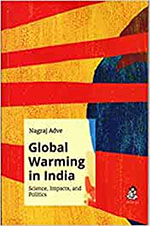
[Published in November 2022, volume 46, No 11 of The Book Review India]
Nagaraj Adve’s Global Warming In India is a brief and practical guide that enables the reader to engage with the discussions, debates and actions about the most pressing social and moral issue before our generation. It is written with a sense of hope and compassion for the “ordinary people” that is largely missing in similar and popular books, which tend to focus more on the specialist and technocratic solutions handed over from above and to which most of us are expected to assent to and participate merely as a consumer or observer. The first chapter about the science of global warming is presented without unnecessary jargons and covers all the concepts necessary to clearly grasp the phenomenon. But where this books differs the most from other popular climate change books is in Chapter 2 where the author identifies the “systematic drivers” of the crisis.
The root cause of climate change is capitalism’s DNA, argues Nagaraj. A society which organizes its most important tasks and goals around the maximization of profits cannot address the needs of the ecosystems or its poor and working people. It produces more and more goods by degrading quality of work and the environment through cost cuttings in pollution prevention and casualizing jobs. Lets recount two (out of many) recent incidents that support this claim. One day after Putin invaded Ukraine the LNG Allies a oil and gas lobbying association wrote an open letter to Joe Biden asking him to expand the fossil fuel infrastructure to fill the export gap in Europe created by the war and also by the sanctions against Russia1. And as a result new gas and oil pipelines have been sanctioned along with $300 million in funding by the US government for the new fossil fuel infrastructure.2 And in India, the Economic Times reported that, “Russia’s invasion of Ukraine has opened arbitrage opportunities so enticing that Reliance Industries Ltd deferred maintenance work at the world’s biggest oil refining complex to churn out more diesel and naphtha after prices surged.”3
It is often claimed that it is taking us so much time to switch from fossil fuels to greener sources of energy because of all the inertia built in from previous decades of planning. But as these cases illustrate the cause of delay is not only past inertia but active investment and development for more fossil fuel dependence in present and for future.
Also, related to this is the Indian government’s policy positions on climate change. The Indian NDCs for the Paris Agreement almost entirely depend on reducing the share of fossil fuel in the energy mix. Nagaraj addresses with the deficiency of such approach in the later chapters. He points out that for actual and meaningful reduction of greenhouse gas emissions the fossil fuels must drop in absolute terms. But this demand is rejected by the Indian government and also by much of the liberal and left critics and environmentalist. They object that why should India, a “developing” nation give up on its opportunity “to grow” for mitigating a crisis created by the richer nations? One answer is being provided by the leaders of the most venerable and island nations. They have been repeatedly saying that India and China are among the top emitters and emerging economies and “while they (India and China) develop; we die; and why should we accept this?”4 The self-image of India created by the Indian intellectuals is very self serving, shifting from a “powerful” nation to “developing poor” nation as the needs of the business and political elites demand. India is the third biggest emitter of greenhouse gases and when it claims its right to more “carbon space” to develop at the cost of islands and coastal communities then, how different is the notion of “carbon space” from Nazi “living space”?
Moreover, as Nagaraj distinctly points out the policies that lead to climate crisis have also led to unparalleled inequality both globally and in India. The NCRB 2021 report reveals that in 2021, 1,64,033 people committed suicide in India, including 5 daily wage earners every hour.5 While, “during the pandemic (since March 2020, through to November 30th, 2021) the wealth of billionaires increased from INR 23.14 lakh crore (USD 313 billion) to INR 53.16 lakh crore (USD 719 billion). More than 4.6 crore Indians meanwhile are estimated to have fallen into extreme poverty in 2020 (nearly half of the global new poor according to the United Nations.) The stark wealth inequality in India is a result of an economic system rigged in favour of the super-rich over the poor and marginalised.”6 So how justified can a business as usual let-India-develop position be when only development seems to be of the top 1% and top 10% of Indians.
The final chapter on solution is filled with thought provoking ideas that are just the right balance of specific and general to help come up with concrete plans while allowing creativity and local needs to be assimilated. But, the solutions have to acknowledge and recognize the faces and the forces responsible for the economic and climate crisis: the billionaires and their corporations.
This book is an essential reading for anyone who wants to make sense of the changes taking place before us and to be a positive part of it.
1https://lngallies.com/energy-security/
2‘How the gas industry used the Ukraine war to secure new fossil fuel infrastructure’ Bulletin of the Atomic Scientists.
3‘Billionaire Mukesh Ambani’s refinery makes millions from war windfall’ Economic Times, May 09 2022
4Quoted in Karin Bäckstrand, Ole Elgström (2013) ‘The EU’s role in climate change negotiations: from leader to ‘leadiator’, Journal of European Public Policy, 20:10, 1369-1386, DOI:10.1080/13501763.2013.781781
5https://frontline.thehindu.com/social-issues/ncrb-2021-report-dying-young-and-jobless-in-india/article65894493.ece
6https://www.oxfamindia.org/press-release/inequality-kills-india-supplement-2022